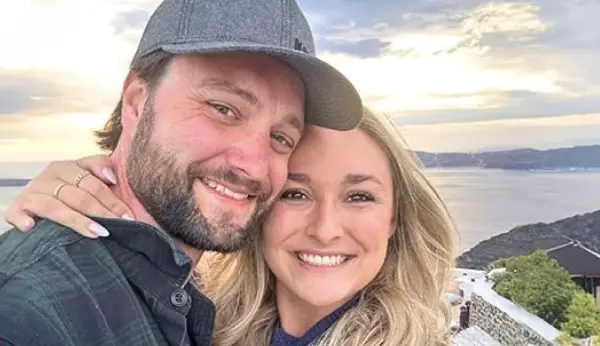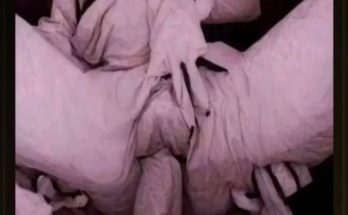Police in the northern Illinois city of Harvard say they are working to establish the sequence of events that left a young Wisconsin couple dead from gunshot wounds inside their car late on the night of October 6, a case that investigators describe as isolated and potentially a murder-suicide but not yet formally ruled. The victims were identified as Rachel Noel Dumovich, 29, and Brandon Peter Dumovich, 30, of Sharon, Wisconsin, who were found less than a week before the first anniversary of their wedding. Responding to questions about the direction of the inquiry, Harvard Police Chief Tyson Bauman said that while a murder-suicide is “a potential scenario,” no final determination has been made and the department is awaiting the county coroner’s findings and additional forensic testing before declaring a manner of death.
According to police, an officer on patrol at about 11:52 p.m. noticed a vehicle stopped in the northbound lane of Division Street—also known as U.S. Route 14—with its hazard lights flashing near Burbank Street. When the officer approached to check on what was initially treated as a disabled-vehicle assist, he found the driver and passenger dead in their seats. The Harvard Fire Protection District was summoned and an alert initially warned that one of the occupants may have shot themselves and still had possession of a firearm. Investigators recovered a gun from inside the vehicle and shut a stretch of Route 14 through the early morning while the McHenry County Major Investigation Assistance Team processed the scene.
Autopsies performed by McHenry County Coroner Dr. Michael Rein found that both victims died of gunshot wounds to the head, according to a statement issued Wednesday. The coroner has not yet ruled on manner of death, a separate classification that will follow once toxicology testing and ancillary forensic work are completed. The coroner’s office is working alongside the assistance team and the state’s attorney’s office to assemble a complete timeline, including ballistic analysis of the recovered weapon and examinations of electronic devices.
Chief Bauman said detectives are reviewing physical evidence and canvassing for additional information, but emphasized that the incident appears to be isolated. The department has stated there is no evidence of an ongoing threat to the public. In an update, Harvard police said they are “diligently” investigating and will release additional information as the case allows, while urging anyone with knowledge to contact investigators directly or via the Crime Stoppers line.
The car was discovered in a residential section of the city not far from the state line with Wisconsin, where the couple lived. The roadway closure ran between Diggins Street and McKinley Street as scene technicians documented the vehicle’s condition, the position of the bodies, bloodstain patterns, cartridge or casing evidence if any, and the location of the firearm. Investigators also photographed the dashboard area and collected data that could establish whether the hazard lights were manually activated or triggered by a system fault. Neighbors were asked to provide doorbell or security camera footage capturing vehicle movements on Division Street in the hour before officers arrived.
As news of the deaths filtered across the state line, colleagues and friends began to post remembrances that echoed details contained in formal obituaries. Rachel Dumovich, a Crystal Lake South High School graduate who earned a business administration degree from the University of Wisconsin–Milwaukee, worked in human resources and was described by those close to her as a driven connector with an expansive circle of friends. Brandon Dumovich served as a petty officer in the United States Navy before building a civilian career that combined sales and technical work, and he was remembered for an easy sense of humor and loyalty to family. Arrangements for public and private memorials were listed by local funeral homes as the community prepared for services at a church in Algonquin and a separate ceremony for Brandon.

Public records linked to the couple’s wedding indicate they married on October 12, 2024, after reconnecting as adults following a friendship that began in middle school. Family and friends have said that the pair shared a love of lakeside life, travel, and time with their two dogs; social media posts in the days before their deaths included images and references to a past trip to Greece, where they spent part of their honeymoon. Those biographical details—ordinary and domestic—have sharpened the shock for relatives contacted by local media, who said they were struggling to reconcile the couple they knew with the violence of the scene police encountered in Harvard.
While investigators have not publicly discussed a motive, the structure of the inquiry so far follows standard practice in suspected domestic murder-suicides. Detectives typically move on parallel tracks: one focused on forensics, including firearm tracing and gunshot residue testing, and another on context, examining communications, financial records, and any history of calls for service or protection orders. In cases where a firearm is recovered within the vehicle and no third party is believed to have fled, police often rely on a combination of trajectory work, wound ballistics, and latent or touch DNA to establish the order of shots and who fired the weapon. Forensic examiners also correlate time stamps from 911 calls, license-plate readers, and phone location data to reconstruct the final movements. Police in Harvard have not disclosed whether any of those elements have yielded definitive results.
The timing and setting—nearly midnight on a Sunday, hazards flashing on a state route inside city limits—have prompted particular attention to the possibility of a planned meeting or a sudden stoppage prompted by an argument or medical event. Investigators have not said whether the vehicle sustained damage suggestive of a crash before stopping, and there has been no public indication of forced entry by a third party. With the road reopened and the car removed from the scene, the laboratory phase of the case has taken precedence: shell casings, if recovered, will be compared with the firearm for class and individual characteristics; any fingerprints on the gun will be assessed in light of handling dynamics that can smudge or obliterate ridge detail; and clothing will be tested for close-range indicators such as soot and stippling that can narrow firing distances.
A central procedural milestone will be the coroner’s manner-of-death determinations. Under Illinois practice, autopsy findings of gunshot wounds to the head set the medical cause, but the manner—homicide, suicide, accident, natural, or undetermined—requires a synthesis of scene, lab, and investigative context. If the coroner rules one death a homicide and the other a suicide in the same event, the law-enforcement narrative generally follows by describing a murder-suicide; if both are ruled suicide, investigators would need separate evidence of a pact or independent self-infliction. Police have not suggested the latter, and their public statements continue to frame murder-suicide as a working scenario pending the coroner’s conclusions.
In the days since the discovery, the department has fielded calls from residents asking whether an assailant might still be at large. Officials have repeated that there is “no evidence to suggest” a continuing danger to the community and have urged against speculation. That language is common in investigations where scene evidence points inward to the occupants of a vehicle and no credible reports of a fleeing suspect or carjacking are logged in the relevant time window. The agency has also asked media and the public to refrain from circulating unverified claims about the couple’s relationship as detectives interview friends, coworkers, and relatives to build an accurate picture of recent stressors or threats, if any.
Local mourning has unfolded alongside the casework. The church hosting Rachel’s visitation announced extended hours to accommodate expected crowds, and a family statement published through funeral-home channels asked for “gentle understanding” as relatives grieve in private. Veterans who served with Brandon have posted remembrances emphasizing his service and mentorship. Former classmates of both victims in Crystal Lake shared photographs from adolescence and early adulthood that, taken together, trace a familiar suburban arc—school sports, lake summers, first jobs—before the couple’s relationship turned romantic in 2022 and led to their wedding last autumn. Those posts have become informal archives for detectives as well, who routinely scrape public social-media material to establish timelines and contacts.
As the investigation proceeds, the McHenry County Major Investigation Assistance Team’s involvement ensures that additional investigators from surrounding agencies can handle interviews, search-warrant drafting, and lab coordination without overtaxing a small municipal department. The team’s structure allows for parallel processing of digital evidence, including phone backups and cloud accounts, which can be critical in determining whether messages, draft notes, or searches point toward intent. Police have not said whether they recovered a note from the vehicle or elsewhere.
For now, the contours of the case remain defined by a handful of confirmed facts: a patrol officer’s late-night discovery of a stopped car with hazards on; a gun recovered inside; autopsies establishing gunshot wounds to the head for both victims; and an investigative posture that treats murder-suicide as possible but unproven while the coroner completes work. The absence of announced suspects, combined with repeated assurances about public safety, suggests detectives have not found evidence of a third party at the scene. The next authoritative developments are likely to come in the form of the coroner’s manner-of-death rulings and, if warranted, a Harvard police statement closing the case with a final narrative. Until then, the department’s appeal stands: anyone with information about the couple’s movements or communications on October 6 is asked to contact investigators directly or through Crime Stoppers.



